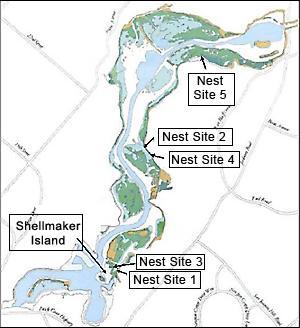 Research Areas > Contaminants > Bioaccumulation of Contaminants in Avian Food Webs
Research Areas > Contaminants > Bioaccumulation of Contaminants in Avian Food Webs
Project: Bioaccumulation of Contaminants in Avian Food Webs
Background and Objectives
Contamination of avian food webs with organochlorine pesticides, PCBs, and heavy and trace metals such as selenium and mercury is a global problem. The tendency of these contaminants to persist in the environment and biomagnify has led to both acute and chronic effects in birds. Estuarine birds are particularly vulnerable because 1) estuaries are the ultimate drainage basins of urban and agricultural runoff from watersheds, making them potential contaminant “hot spots” and 2) the birds are already stressed by habitat loss/fragmentation and other anthropogenic impacts. Reproductive impacts of contaminants are especially problematic for threatened and endangered species, which have limited genetic pools. Upper Newport Bay (UNB) is an ecological reserve that serves as refuge, foraging, and breeding grounds for a number of federal- or state-listed threatened and endangered species, including the light-footed clapper rail (Rallus longirostris levipes). UNB was placed on the federal 303(d) list of impaired water bodies in 1996 due to contamination from heavy metals (copper, cadmium, lead, selenium and zinc), organochlorine pesticides (chlorpyrifos, chlordane, DDT), and PCBs.
To estimate the risk of contaminant exposure in birds, contaminant concentrations are typically measured in various components of their diet and surrounding environment, as well as through direct indicators of exposure (i.e., bird eggs). The objectives of this study were to:
1) Determine the concentration and degree of bioaccumulation of heavy metals (including selenium) and organochlorine compounds in the food web of the clapper rail within the Upper Newport Bay ecosystem
2) Evaluate contaminant impacts on clapper rails by examining nonviable eggs for evidence of egg shell-thinning or embryo developmental abnormalities
Status
This project was completed in 2005.
Methods
The study design for this project consisted of collecting samples from three trophic levels representing the food web of the clapper rail: 1) sediments, 2) benthic macroinvertebrates, and 3) non-viable eggs of the clapper rail (or viable eggs of a surrogate species such as the black-necked stilt (Himantopus mexicanus). Target organisms for the benthic macroinvertebrate sampling included: horn snails (Cerithidea californica), fiddler crabs (Uca crenulata) or lined shore crabs (Pachygrapsus crassipes), amphipods (various species), and isopods (various species). Mussels (specifically ribbed horse mussels or Ischadium demissum) do not represent a primary food source, but are occasionally eaten by clapper rails. These organisms were abundant around the nest sites and were therefore also collected.
Each of the clapper rail eggs was opened to determine its fertility, stage of development, the position of its embryo in the egg, and whether pipping had occurred (i.e., the embryo had begun to break through the shell). Evidence of physical deformities and measurements of eggshell thickness were also noted.
A total of 28 organochlorine pesticide compounds, 46 PCB congeners, and 24 heavy and trace metals were selected for analysis in sediments, prey organisms, and tissues. Sediments were also analyzed for total organic carbon (TOC) and grain size, and tissue samples were also analyzed for percent lipids.

Figure 1. Map of UNB showing locations of the five sites where clapper rail eggs, sediments, and macroinvertebrates were collected.
Findings
Significant findings were as follows:
• DDT and its metabolic products (DDTs), technical chlordane compounds, selenium, and mercury were both present and biomagnified in the food web of the light-footed clapper rail in UNB. Of these compounds, 4,4’-DDE was the contaminant of greatest concern: DDE concentrations exceeded screening levels for sediments and birds, and embryonic abnormalities and eggshell thinning (Figure 2) were found in clapper rail eggs containing elevated DDE concentrations. DDE may be, to a limited extent, impairing reproduction in UNB clapper rails.
Figure 2. Relationship between clapper rail eggshell thickness and 4,4’-DDE concentration.
• Results indicated that impairment due to DDTs is likely declining over time. UNB is currently home to the greatest number of clapper rail breeding pairs in southern California, a number which has increased from 103 to 174 between 1982 and 2005.
• The lack of PCBs and chlordane in sediments and prey organisms, plus low levels in rail eggs, indicated that these contaminants are not likely to be cause for concern. Other organochlorine compounds were at non-detectable concentrations in sediments, prey organisms and eggs.
• The majority of sediment samples from the five nest sites had selenium (Se) concentrations which exceeded toxicity effects levels, while concentrations in prey organisms frequently exceeded projected dietary screening values for aquatic birds. However, Se concentrations in rail eggs were below the “no effect” range. This fact, along with the lack of apparent characteristic deformities in the embryo (e.g., reduced or missing eye), ruled out selenium toxicity.
• Due to the exclusive use of non-viable eggs, these results present a worst-case scenario appropriate for a screening level study. Further study is recommended to determine the extent to which DDTs and selenium may be impairing reproduction of the clapper rail in Upper Newport Bay.
Partners
This project was conducted in collaboration with Orange County Water Management District and Ch2M Hill, Inc.
This page was last updated on: 7/1/2014